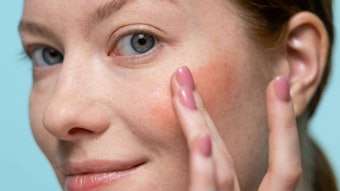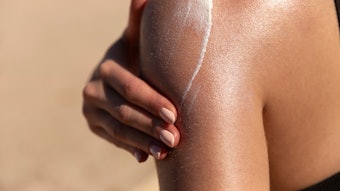- Evidence shows that one of the best additional measures against sun damage may be buttressing the skin’s own defense mechanisms.
- Some antioxidants are structured to preferentially absorb the most harmful wavelengths of UV light.
- There are ingredient options that can improve the physical structure of the skin, and studies indicate that specific ingredient complexes can protect DNA against UV-initiated damage.
For millennia, civilization has revered the sun for its life-giving light, heat and energy. Only recently has it been learned that it’s also the source of wrinkles, erythema and the DNA damage that can lead to skin cancer. Estimates of the extent to which skin damage is the result from solar radiation run as high as 90%, and you don’t have to be a beach bum to suffer your fair share. It’s those episodic, everyday exposures—en route to the car or taking the dog for a walk, as examples—that add up throughout the years and put both your skin’s health and its appearance at risk.
But if leading an active, healthy lifestyle involves logging serious outdoor time—and it does—people need an effective means of enjoying the sun’s gifts while avoiding its dangers. The more you learn about such benefits to dermal health as, carotenoid antioxidants, the more you learn that your best defense against the damaging effects of the sun may be your own properly nourished skin itself.
Seeing the Light
As frustrating as it may be, some aspects of dermal aging are beyond our control. The passage of time and its wear and tear on the skin are inevitable, as are the genetic changes programmed into our DNA to kick in as we get older. But the aging attributable to environmental stressors such as cigarette smoke, pollution and poor nutrition is largely controllable—as is, given the right preventive measures, the photo-aging attributable to sunlight.
Sunlight spans the spectrum from low-wavelength gamma rays to high-wavelength radio waves—between which lie ultraviolet (UV) light, ranging in wavelength from 290 to 400 nanometers, and the visible spectrum, between 400 and 760 nanometers in wavelength.
When you think of sunlight and skin damage, you tend to think first of the UV spectrum. Within the UV range, UVA rays are the longest and, until recently, were thought to be the least harmful. However, new studies indicate that UVA is quite damaging, because it can contribute to collagen breakdown and, notably, DNA damage in melanocytes—which can lead to cancer. Furthermore, UVA radiation can pass through windows both at home and in the car while driving, causing extensive damage. UVB rays, with midrange wavelength, are associated with skin cancers such as melanoma, as well as the reddening, or erythema, of sunburn. The shortest and most dangerous are the UVC rays, and though the ozone layer has historically blocked this spectrum, continual depletion of that barrier may render them a worrisome new consideration for those concerned about skin health.
Photo Finish
How light rays age skin involves a basic process of photooxidation. As David Djerassi, wellness and nutricosmetic expert for LycoRed, Ltd., Beer Sheva, Israel, explains, “UV light penetrates the skin, causing the formation of UV-induced free radicals.” Among these is singlet oxygen, a harmful reactive oxygen species, or ROS, that tips the skin’s homeostasis off balance—destroying tissues, oxidizing lipids, cleaving genes and setting off a chain reaction that generates additional harmful reactive species, including hydroxyl radicals and superoxide anion. “There is also new information suggesting that only 50% of the free radicals generated in skin are caused by exposure to UVB and UVA radiation, and the other 50% are caused by visible light,” Djerassi adds.
As with chronological aging, photoaging manifests in external and internal effects: reduced cell turnover, delayed wound healing, cross-linking of collagen, loss of skin elasticity, dermal thinning, roughness and blotchiness. But photoaging assaults skin further still. The oxidative stress initiates inflammation and reddening that shows up as erythema. In the dermis, or inner layer of skin, UV light triggers the buildup of abnormal elastin damage and breaks down collagen at a faster rate than natural aging; eventually, these disorganized proteins show up as solar scars and, with time and continued accumulation, become wrinkles. And perhaps most worrisome, the sun attacks the skin’s genes, mutating mitochondrial and nuclear DNA so as to increase cell dysfunction and death and possibly precipitate skin cancer.
It doesn’t take much exposure to set these events into motion. Not only do studies show that the sun time during a conservative vacation accounts for only about a third of the annual average UV dose—another reminder that most UV exposure takes place at home, every day—but, says Djerassi, “Clinical evidence demonstrates that just one day of unprotected sun exposure can cause irreversible cell damage, which is associated with both morphological and histological changes. These changes can lead to premature aging of the skin.” And they offer further proof that you need more sun protection than you think.
Protection From the Inside Out
Typically, sun protection has taken an exogenous form—coming from the outside by way of clothing or topical sunscreens. But long sleeves and pants aren’t always practical, and studies of the composition of sunscreens show that only 16% of those currently marketed contain both UVA- and UVB-filtering ingredients. As much as 13% of the sunscreens with a sun-protection factor, or SPF, of at least 30 screen only UVB rays, lacking any ingredients to block the aging and DNA-damaging UVA. And as if that weren’t enough, analyses reveal that fully 54% of available sunscreens contain UV-blocking ingredients that themselves are vulnerable to photooxidation, breaking down in a matter of hours or sometimes even minutes.
The upshot is that exogenous sunscreens, though widely and wisely touted as a tool in the sun-protection kit, may leave the public with a false sense of security against sun damage. Only by augmenting our use of sunscreen with additional measures can wraparound protection be enjoyed, and evidence from the world of nutrition science shows that one of the best additional measures may be buttressing the skin’s own defense mechanisms. The not-so-secret weapon for enhancing the skin’s endogenous defense is to consume plenty of antioxidants, nutrients found primarily in colorful fruits and vegetables and uniquely suited to protect against oxidation’s assault.
Some antioxidants—particularly the carotenoids—are structured to preferentially absorb the most harmful wavelengths of UV light, quenching free radicals, protecting the skin, strengthening collagen and elastin, stanching inflammation and DNA damage, and altogether putting the brakes on photo-oxidative stress. By “stockpiling” our cellular stores of carotenoid antioxidants, either through diet or supplementation, we concentrate these phytonutrients where we need them most, thus priming our skin to protect itself. “We have to supply the body and skin at all ages to assist it in fighting ROS, DNA damage and environmental assault,” says Udi Alroy, vice president, global marketing and sales, LycoRed. “By assisting the daily fighting mechanism, we are actually freeing the skin to create its own defense mechanisms.”
Food, beverage and supplement manufacturers have seized on this emerging science to create whole new families of functional foods and beverages intended to protect not only skin health, but its appearance, as well. Call them nutricosmetics, cosmeceuticals or plain-old beauty foods, they provide “beauty from within” by shoring up the skin’s endogenous supplies of light-fighting antioxidants. Popular delivery formats include beverages, bars, gums, chews and supplements that promise to increase skin density, elasticity, thickness and smoothness.
Broad-spectrum Protection It’s no coincidence that of the 600-plus carotenoids found in fruits and vegetables, 20 also occur naturally in human plasma and tissues. These include lycopene, alpha-carotene, beta-carotene, lutein, phytoene, phytofluene, astaxanthin and zeaxanthin, and the organ in which they are seen doing some of their best work is the skin.
Consider alpha- and beta-carotene. Their ability to quench singlet oxygen complements the phyto-protective activity of other carotenoids, and they have a demonstrated ability to reduce collagen breakdown by down regulating the activity of the enzyme collagenase.
Alpha- and beta-carotene also protect skin lipids from oxidation and stimulate intercellular communication, helping regulate skin growth and renewal. In a joint meta-analysis of seven 10-week oral supplementation studies—researchers at Munster University Hospital and Heinrich-Heine University in Düsseldorf, Germany, found that beta-carotene acted as an effective antioxidant, protecting against the development of sunburn reactions and (in supplementation regimens lasting beyond 10 weeks) providing additional photo-protection.
Better still, combining the beta-carotene with lycopene and lutein boosted its protective effects even further.
Lutein, along with astaxanthin and zeaxanthin, exhibits skin-protective benefits of its own. All three carotenoids are well-known and appreciated for their role in reducing risk for age-related macular degeneration, but studies show that daily lutein supplementation can increase skin hydration, reduce lipid peroxidation and enhance skin elasticity—in addition to strengthening the skin’s natural antioxidant system. Researchers in the Department of Applied Cosmetic Dermatology at the University of Naples, Italy, demonstrated that 12 weeks of oral supplementation with 10 mg of lutein per day, in conjunction with topical lutein application of 50 ppm, protected the skin against solar radiation, improved skin hydration and elasticity, and increased superficial lipid levels. Quantitatively, the researchers found the lutein treatment decreased lipid oxidation by 55%.
Code Red
Lycopene is a carotenoid whose photo-protective benefits have been demonstrated thoroughly. Lycopene is found in a number of fruits and vegetables, where it lends a telltale red color, but the signature source for natural, biologically active lycopene is the tomato. “We get lycopene from red, ripe tomatoes, where Mother Nature built it in to protect the fruits themselves from the full range of the sun’s light, from UV through visible,” Alroy says. In tomatoes and other lycopene-rich plants, the pigment confers its protection with the help of other antioxidant carotenoids, such as the colorless phytoene and phytofluene, which absorb light in the UV range—while lycopene’s absorption maxima lies in the visible range. A 1989 study published in the Archives of Biochemistry and Biophysics found that it is lycopene’s unique double-bonded structure that makes it the most efficient quencher of singlet oxygen among the biologically occurring carotenoids.
The tomato antioxidants operate in the human body much as they do in the tomato, providing skin cells with broad-based solar protection. Lycopene’s skin-protecting capacity has proven itself in numerous studies. For example, in 2009, scientists at the Dermatology Consulting Institute in High Point, North Carolina, found that subjects treated to 10 weeks of daily oral supplementation with 10 mg of lycopene* experienced a threefold reduction in sunburn cells after exposure to 2 MEDs (minimal erythemal doses) of UVB and UVA radiation—as compared to subjects taking a soybean-oil placebo.
* LycoRed Ltd.’s Lyc-O-Mato, a tomato lycopene complex containing all the phytonutrients found naturally in tomatoes, was used.
Supplementation with “lycopene complexes” can also improve the physical structure of the skin, as researchers at the Institute of Experimental Dermatology of Witten/Herdecke, Germany, found.
Measuring skin structure parameters after 12 weeks of supplementation with an antioxidant mix of lycopene, lutein, beta-carotene, alpha tocopherol and the antioxidant mineral selenium, they found increases in skin density of 7% and increases in skin thickness of 14%. Meanwhile, those in the placebo group only saw a 0.3% increase in skin density and actually lost skin thickness at a rate of 1.4%. Analysis of scaling and roughness in the supplement group showed decreases of 60% and 33%, respectively, while decreases in the control were only a respective 30% and 16%.
Evidence also indicates that these ingredient complexes can protect DNA against UV-initiated damage. Scientists at the Department of Food Science and Technology at the University of Milan, found that a 26-day course of beverage supplementation with Lyc-O-Mato 6% elevated concentrations of lycopene, phytoene, phytofluene, and beta-carotene in the plasma and lymphocytes of study subjects improved resistance to DNA damage from UV exposure by more than 40%.
“Complements” of the House
One theme consistent among all the aforementioned studies is that they don’t owe their encouraging results to isolated lycopene alone; each supports the superior efficacy and biological activity of the full complement of carotenoid pigments found in the tomato lycopene complex—reflecting the “natural complex of antioxidants found naturally within the whole tomato,” according to Alroy, who also notes, “The extracts are standardized to contain representative proportions of lycopene, phytoene, phytofluene, vitamin E tocopherols and beta-carotene.”
And going straight to the natural source is a critical factor in ensuring biological activity, too. Numerous studies demonstrate that a natural lycopene complex extracted directly from the whole tomato delivers a more potent photo-protective advantage than synthetic ingredients. In a study conducted at the institute for Biochemistry at the Heinrich-Heine University of Düsseldorf, two groups received 1.25 MEDs of solar radiation; after 12 weeks, the group consuming synthetic lycopene showed only 25% reduction in erythema, while the group consuming an all-natural, tomato-derived complex with a full complement of antioxidant components, enjoyed a 38% reduction.
“Mother Nature knew what she was doing when she created the tomato,” Alroy says. And her handiwork has made it easier for all of us to feel good about enjoying your day in the sun. “After hearing all the advice to stay in the shade and make sunscreen application an everyday ritual,” continues Alroy, “isn’t it gratifying to learn that we can strengthen the skin itself with foods or supplements whose antioxidants provide a powerful antidote to solar damage? Take them regularly when indoors and for casual daily outdoor activities, and in combination with sun care products for heavy sun exposure. Do that and there’s no reason to be afraid from the sun, at any age.”
Kimberly J. Decker is a California-based technical writer. She holds a bachelor’s degree in consumer food science, with a minor in English from the University of California, [email protected].










